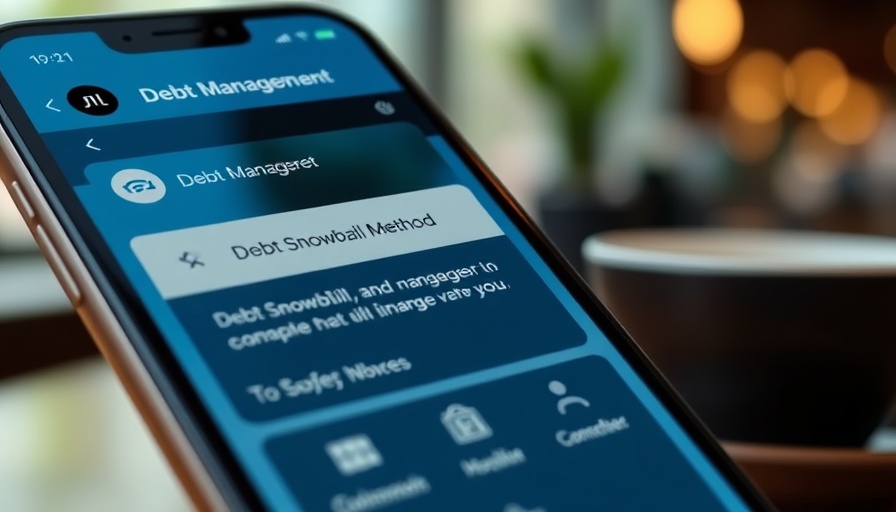
Understanding the Debt Snowball Method: A Path to Financial Freedom
In the pursuit of financial wellness, the debt snowball method emerges as a widely favored strategy for those looking to take control of their financial obligations. This approach allows individuals to focus on their smallest debts first, fostering motivation through early wins as they progressively pay off larger balances. Unlike strategies that prioritize interest savings, such as the debt avalanche method, the snowball method emphasizes psychological boosts from visible progress. This makes it particularly appealing for people seeking to ease their debt burden and build confidence in their financial decision-making.
Top Apps to Master the Debt Snowball Method
If you're ready to embrace the debt snowball approach, various technology tools can support you on this journey. The following five applications stand out for their unique features that assist in managing and tracking debt repayment using this strategy:
1. Undebt.it: A Comprehensive Tracking Tool
Undebt.it is a versatile platform that supports multiple debt repayment strategies, including both the snowball and avalanche methods. With the ability to input personal debts, users can select their preferred repayment plan and visualize their progress through detailed charts and timelines. What sets Undebt.it apart is its “debt snowflakes” feature, enabling users to make one-time extra payments when extra cash is available, thereby accelerating their debt repayment efforts. While Undebt.it offers a premium option (Undebt.it+) with advanced features like bill tracking, the free version is robust enough for most users.
2. Debt Payoff Planner: Visualize Your Repayment Plan
The Debt Payoff Planner app is an intuitive tool designed to help users create and visualize a personalized debt repayment plan. It allows you to input your debts, set payment goals, and receive reminders, keeping you accountable on your journey to financial freedom. The clear layout and easy-to-use interface make it a solid choice for anyone looking to stick to the debt snowball method.
3. Bright Money: AI-Powered Debt Management
For those interested in a tech-savvy approach, Bright Money uses artificial intelligence to analyze users' spending habits and automate debt payments. This app is particularly effective for reducing high-interest credit card debt as it creates tailored financial plans and automates payments. Users should note, however, that linking bank accounts is necessary for optimal performance, and subscription costs may apply.
4. Ramsey Snowball Calculator: Simple and Straightforward
Developed by Ramsey Solutions, the Debt Snowball Calculator is a free online tool that offers simplicity and clarity for users wanting to plan their debts. Users can list their obligations from smallest to largest, and the calculator generates a step-by-step repayment plan, estimating the time needed to become debt-free. This straightforward approach helps to create motivation by focusing on quick wins that bolster confidence.
5. You Need a Budget (YNAB): Comprehensive Budgeting with Debt Focus
You Need a Budget (YNAB) goes beyond standard budgeting by incorporating debt payments into a user’s financial strategy. As a zero-based budgeting app, YNAB requires users to allocate every dollar of their income, which can include prioritizing debt repayment. Incorporating features like real-time bank syncing and expenses tracking, YNAB empowers users with the knowledge and discipline they need to tackle multiple debts effectively.
Staying Motivated and On Track
Using the debt snowball method is only half the battle; the other half involves consistently following through. Here are some essential tips to help you maintain your momentum:
- Stick to Your Payment Schedule: Always prioritize making at least the minimum payments on all debts, with additional funds directed toward the smallest balance.
- Utilize Extra Money: Channel bonuses, tax refunds, or side hustle income toward your target debt, pushing you further down the path to completing your repayment goal.
- Avoid New Debt Accumulation: Resist the temptation to take on new debts during your repayment period. This will ensure that your hard work pays off without distractions.
- Celebrate Achievements: Keep your morale high by celebrating small victories. Marking milestones can offer an invigorating boost and maintain focus on your larger goal of a debt-free life.
Exploring Additional Debt Management Strategies
While the debt snowball method is effective for many, it's important to consider supplementary strategies that could further improve your financial health. For instance, debt consolidation might be an option to explore if you have multiple high-interest debts and are looking for a way to manage payments more effectively. Alternatively, engaging with credit counseling services can offer personalized advice tailored to your unique financial situation.
Conclusion: The Journey to Debt-Free Living
Embracing the debt snowball method can yield significant benefits in both monetary savings and peace of mind. By utilizing apps designed to guide you through the repayment process, developing a tailored action plan, and staying disciplined, you can break free from the chains of debt and start building a secure financial future. Remember, the path may be challenging, but consistent effort can lead to rewarding results.
 Add Row
Add Row  Add
Add 



Write A Comment